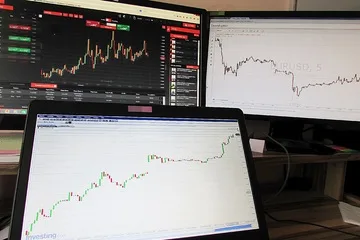In the bustling world of stock markets, day trading technical analysis is a pivotal tool for both novice and seasoned traders alike. This powerful technique arms traders with the knowledge needed to make informed decisions and execute successful trades. This comprehensive guide is meticulously curated by John Doe, a seasoned trader with a decade-long experience in financial markets, to provide an insider’s perspective on mastering the art of technical analysis.
Understanding Day Trading Technical Analysis
Day trading technical analysis involves evaluating price movements and trading volumes to forecast future price trends. By understanding historical data, traders can predict and capitalize on short-term market movements.
The Science Behind It
Technical analysis is backed by the Dow Theory and the Efficient Market Hypothesis. These principles assert that all current market information is reflected in stock prices and that prices move in trends influenced by the collective psychology of market participants.
The Tools of the Trade
- Candlestick Patterns: These visually represent price movements in a specified time frame.
- Moving Averages: This tool helps smooth out price data to identify the trend direction.
- Relative Strength Index (RSI): It gauges the momentum and speed of price movements.
- Volume Analysis: This analyzes the number of shares traded during a particular timeframe.
Why is Day Trading Technical Analysis Essential?
Day trading technical analysis offers traders a means to understand market trends and enhance their trading strategies. This methodology allows for quick decision-making, essential for the fast-paced nature of day trading.

Real-time Experiences and Examples
Let’s delve into a real-time experience. Consider a trader who observes a bullish engulfing candlestick pattern. By leveraging day trading technical analysis, they can predict a potential upward movement and make a profitable trade.
Mastering the Techniques
Success in day trading requires constant learning and adaptation. Consider enrolling in courses or seeking mentorship from seasoned traders to continuously sharpen your skills.
Common day trading strategies
1. Momentum Trading
- Traders focus on stocks or assets that are moving significantly in one direction, typically on high volume.
- Example: If a stock is consistently rising following a news release, a momentum trader may buy and ride the trend until it shows signs of reversal.
2. Scalping
- Scalping involves making dozens or even hundreds of trades in a single day to “scalp” a small profit from each.
- Example: A scalper may buy a stock at $10 and sell it at $10.05, capturing the small price movement.
3. Range Trading (or Swing Trading)
- Traders identify stocks that are moving within a certain range and aim to buy at the low point and sell at the high point of that range.
- Example: If a stock is oscillating between $30 and $31 throughout the day, a range trader would aim to buy at $30 and sell at $31
4. Pullback Trading
- Traders look for stocks that are experiencing a short-term pullback in an overall upward trend.
- Example: If a stock has been trending up but experiences a small decline, a pullback trader may see this as an opportunity to buy before the upward trend resumes.
5. Breakout Trading
- Traders look for stocks breaking out of a defined resistance level as an indication of a strong upward movement.
- Example: If a stock has repeatedly failed to surpass $50 but finally breaks through, a breakout trader may buy, anticipating further increases.
6. News-Based Trading
- Traders leverage news releases and market announcements to predict market moves.
- Example: If a company announces positive earnings, a trader may buy the stock expecting its value to increase.
7. Reversal Trading (or Mean Reversion)
- Traders bet against the current trend, expecting it to reverse.
- Example: If a stock has been consistently falling, a reversal trader might anticipate that it will start to rise and place trades accordingly.
8. High-Frequency Trading (HFT)
- This strategy uses powerful computers to transact a large number of orders at extremely high speeds.
- Example: HFT firms make profits by arbitraging price differences across different markets or similar instruments.
9. Gap and Go Strategy
- Traders focus on stocks that have a gap up or down in the morning and then look for the trend to continue.
- Example: If a stock closed at $10 yesterday but opened at $12 today, a trader might anticipate further upward movement
10. Pivot Point Trading
- Traders use pivot points, which are levels of support and resistance, to determine when to enter and exit trades.
- Example: If a stock price reaches a predetermined support level and shows signs of bouncing back, a trader might buy anticipating an upward movement.
Each of these strategies requires a good understanding of market conditions and a well-thought-out plan. It’s important to practice and refine your strategy to find what works best for you.
The Most Effective Day Trading Strategy
There isn’t a definitive “best” strategy when it comes to day trading, as the effectiveness of a strategy can depend on various factors such as the trader’s experience, risk tolerance, investment capital, and the market conditions at a given time.
Momentum Trading might be suitable for traders who can quickly interpret and act on market trends. Scalping can be beneficial for those who can dedicate time to closely monitor small market movements. On the other hand, News-Based Trading might be more suited to traders who excel at interpreting news and predicting its impact on stock prices.
Ultimately, the best strategy is one that aligns with a trader’s individual goals, skills, and risk appetite. It is often recommended for traders to explore different strategies, practice them in a simulated environment, and continually refine their approach based on their experiences and the evolving market conditions.
What is day trading technical analysis?
It is a technique where traders analyze price movements and volumes to predict future trends.
How reliable is day trading technical analysis?
While it is not foolproof, it is a widely practiced method backed by established theories.
Can beginners learn day trading technical analysis?
Absolutely! There are numerous resources and courses available for beginners.
Is technical analysis applicable to other forms of trading?
Yes, it can be applied to various trading forms, including swing trading and long-term investing.
What tools are used in day trading technical analysis?
Tools include candlestick patterns, moving averages, RSI, and volume analysis.
How does psychology play a role in day trading technical analysis?
Market psychology influences buying and selling decisions, affecting price movements.
How often should one review their day trading strategy?
Regular review and adaptation to market conditions are crucial for a successful strategy.
What’s the significance of volume in day trading technical analysis?
Volume analysis helps in confirming trends and spotting potential reversals.
How does day trading technical analysis differ from fundamental analysis?
Technical analysis focuses on price movements, while fundamental analysis looks at economic factors.
Where can I learn more about advanced trading techniques?
Platforms like Wrap Your Cars offer valuable insights and resources.
Conclusion:
In conclusion, day trading technical analysis serves as a strategic compass for traders, allowing them to navigate the volatile seas of the financial markets with precision and insight. By leveraging tools such as candlestick patterns, moving averages, RSI, and volume analysis, traders can interpret market signals and make informed decisions. This approach, when mastered and continually refined, can significantly enhance the likelihood of successful trades. Embracing technical analysis is thus a vital step for anyone aspiring to excel in the world of day trading. For more helpful tips and information on trading, check out our website The Market Technicians.
Disclaimer: Trading carries inherent risks, and previous performance does not guarantee future outcomes. The content presented in this article is solely for educational purposes and should not be construed as financial counsel. We strongly recommend consulting a certified financial expert before initiating any trading activities.
Note: The material within this article is provided for informational purposes exclusively and should not be seen as a replacement for expert financial guidance. Whenever you have inquiries concerning your investments or trading methods, always seek the guidance of a qualified financial advisor.
Affiliate link disclaimer: Some links in this article may earn us a commission for any resulting purchases. Thank you for supporting our content.






Enhance your privacy on Ethereum with TornadoCash. Enjoy secure and confidential transactions without compromising on decentralization.
Thanks for sharing. I read many of your blog posts, cool, your blog is very good.